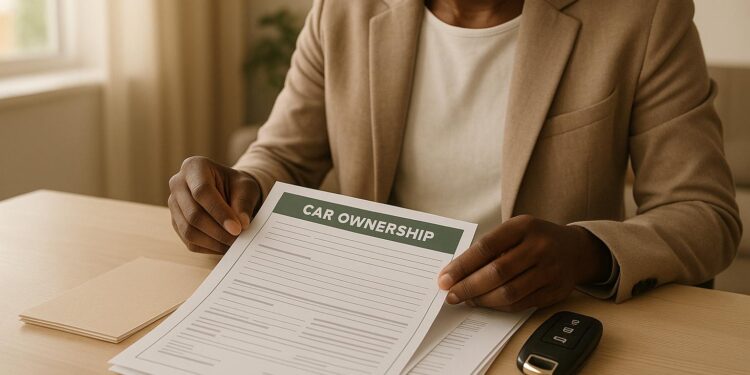If you’re transferring car ownership in Uganda, here’s what you need to know:
- Key Documents: You’ll need valid identification, the vehicle’s registration book, a completed transfer form, and proof of fee payments. For companies, additional documents like a certificate of incorporation and tax compliance certificate are required. Special cases, such as deceased or absent owners, may involve affidavits or court approvals.
- Process: Gather all required documents, pay the applicable fees via the Uganda Revenue Authority (URA), and submit your application at the designated office.
- Fees: Costs vary based on vehicle type, engine size, and usage. Additional expenses may include document certification, legal assistance, and penalties for delays.
Proper preparation ensures a smoother process. Keep all documents in order, settle any outstanding dues, and consult the URA for updated fee details.
Selling Your Car? How to Transfer Ownership Fast in Uganda
Required Documents for Car Transfer
Having the right paperwork in place is key to ensuring a smooth car transfer process in Uganda. Whether you’re buying or selling, being prepared with the necessary documents can help you avoid unnecessary delays and complications. Below, we break down the required documents based on the type of transfer.
Documents for Individual Transfers
For individual transfers, both the buyer and seller need to provide valid government-issued identification, such as a national ID or passport, to confirm their personal details. It’s also important that the vehicle’s registration book matches the seller’s ID.
You’ll need to submit a completed and signed transfer form to officially record the change of ownership. Additionally, ensure all transfer fees, taxes, and duties are fully paid, and any outstanding fines or loans tied to the vehicle are cleared before starting the transfer process.
Documents for Company Transfers
When a company is involved in the transfer, additional paperwork is required. Along with the standard documents, you’ll need to provide:
- A certificate of incorporation to confirm the company’s legal status.
- A consent letter signed by authorized representatives of the company.
- Written authorization for the individual handling the transfer.
- Updated business registration documents, a tax compliance certificate, and a Tax Identification Number (TIN) to demonstrate compliance with legal and tax obligations.
Documents for Special Cases
Some transfers involve unique circumstances that call for extra documentation:
- For deceased owners: If letters of administration are available, the vehicle must first be transferred to the beneficiary. If the owner is a minor, approval from a High Court judge is required.
- For absent or missing owners: An affidavit or statutory declaration sworn before the Commissioner for Oaths is necessary. You’ll also need to publish a public notice in a daily newspaper, announcing the transfer intention and allowing two weeks for objections from the registered owner.
In all cases, you must provide the original registration book, a completed transfer form, proof of paid assessment fees, and a vehicle verification report for the process to proceed.
Car Transfer Process Steps
Once you’ve gathered all the required documents, the car transfer process involves three key steps: organizing your paperwork, paying the necessary fees, and submitting your application.
Document Preparation
Make sure all your documents are in order – this includes your ID, proof of ownership, and any required forms. Double-check everything to avoid unnecessary delays or complications.
Paying the Fees
The Uganda Revenue Authority (URA) handles the fee payment process. Start by generating a Payment Registration Number (PRN). You can do this at a URA office or through their online platform. Payments can be made online, via mobile money, or through bank transfers at URA offices. Be sure to keep your payment receipts and PRN details handy for reference.
Submitting Your Application
Head to the designated office during their working hours to submit your application along with the PRN confirmation. The officials will review your submission and guide you on the next steps.
sbb-itb-7bab64a
Transfer Fees and Costs
Understanding the fees set by the Uganda Revenue Authority (URA) and the Ministry of Works and Transport is crucial to avoid any surprises. These fees are determined by several factors, including the type of vehicle, engine size, and its intended purpose. Here’s a breakdown of the base fees and other possible expenses you might encounter.
Official Fees by Vehicle Type
The base fees for vehicle transfers are influenced by the vehicle’s category, engine capacity, and usage. For instance, cars with smaller engines typically have lower fees, while those with larger engines or vehicles used for commercial purposes tend to incur higher costs. To stay updated, it’s a good idea to refer to the URA’s official fee schedule.
Extra Costs
In addition to the standard transfer fees, there are often other expenses to consider:
- Document Certification: You may need to certify ownership papers, identification documents, or company certificates, which could come with additional charges.
- Legal Documentation: Complex cases may require legal assistance, adding to the overall cost.
- Penalties for Delays: Failing to complete the transfer promptly could result in fines or penalties.
- Administrative Charges: Imported vehicles or company-owned vehicles may require extra administrative processing, which can increase costs.
- Miscellaneous Expenses: Trips to URA offices, photocopying documents, or other minor tasks can also add up.
Because total costs can vary depending on the type of vehicle and the specifics of the transfer, it’s always wise to consult the URA and other relevant authorities for the most accurate and up-to-date fee information.
Special Transfer Situations
Transfers with Absent Sellers
In Uganda, it’s possible to transfer vehicle ownership even if the seller is not physically present. To do this, the buyer must provide all the required proof of purchase. Additionally, the process involves submitting a notarized affidavit or statutory declaration, along with a publicly published notice confirming the seller’s absence.
This procedure works alongside the standard vehicle transfer process, ensuring legal compliance even in cases where the seller cannot participate directly. For detailed information on the documentation needed in such situations, see the ‘Documents for Special Cases’ section.
Conclusion
Transferring car ownership in Uganda involves following the right steps and having the necessary paperwork in order. Let’s recap the essentials to keep the process smooth and hassle-free.
First, accurate documentation is crucial. Without complete and correct paperwork, you risk delays and extra costs. Once your documents are in order, handling the required fees becomes much simpler.
Speaking of fees, these can differ widely depending on factors like the vehicle’s type, age, and value. For detailed information, check out the "Transfer Fees and Costs" section to plan your budget effectively.
If you’re dealing with more complicated scenarios – such as company-owned vehicles, missing sellers, or imported cars – you may need additional documents like notarized affidavits or customs clearances. In such cases, it’s smart to consult a professional to navigate any tricky legal or procedural requirements.
FAQs
What can I do if the car seller is unavailable during the transfer process in Uganda?
If the car seller is unavailable during the transfer process in Uganda, the first step is to collect all the necessary documents. These include proof of purchase, your identification, and the vehicle’s old logbook. Once you have these, contact the Uganda Revenue Authority (URA) for guidance. They can provide detailed instructions on how to proceed if the seller cannot be reached.
In situations where the seller is deceased or unwilling to cooperate, you may need to secure a court order. This legal step ensures the transfer is completed properly and safeguards your ownership rights.
What are the transfer fees for my vehicle type and engine size in Uganda?
The cost of transferring vehicle ownership in Uganda varies depending on the type of vehicle. For instance:
- Motor cars and dual-purpose vehicles: UGX 84,000
- Motorcycles: UGX 74,000
- Commercial vehicles, trailers, and tractors: UGX 104,000
Keep in mind, these fees can differ based on specific factors like engine size.
To get the exact fee for your vehicle, it’s best to consult the Uganda Revenue Authority (URA). They provide comprehensive details about charges and the required documentation. Having all your paperwork in order will help make the process smoother.
What steps should I follow to transfer ownership of a company-owned vehicle in Uganda?
When transferring ownership of a company-owned vehicle in Uganda, there are specific steps you’ll need to take to meet legal requirements. Start by preparing the company’s certificate of incorporation and registration documents. Along with these, both the buyer and seller must complete and sign a Transfer Form (TR Form 3), and the signatures must be provided in person.
Next, submit all the necessary paperwork through the URA eTax portal or another approved system. Be sure to include a verification report that confirms the vehicle’s details, as well as clear identification for the applicant. Following these steps ensures the transfer process aligns with Uganda’s regulations for company-owned vehicles.
Related Blog Posts
- How To Transfer Car Ownership In Uganda
- How to register a used car in Uganda
- Complete guide: transferring car ownership in Uganda (2025)
- How to change vehicle ownership and title in Uganda




